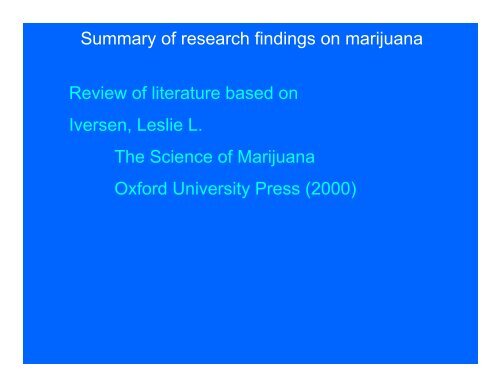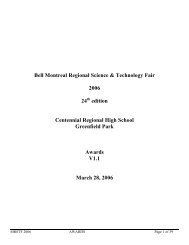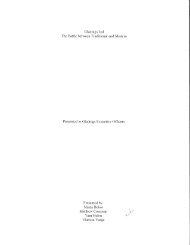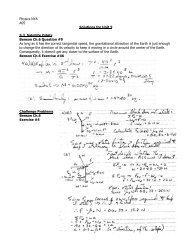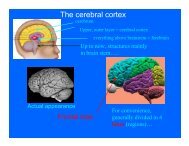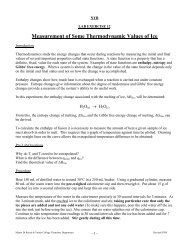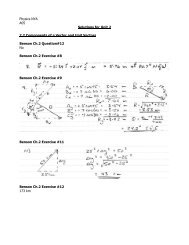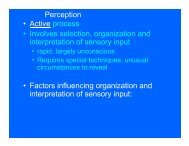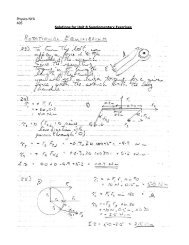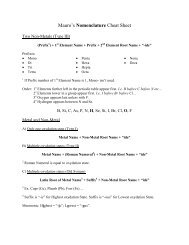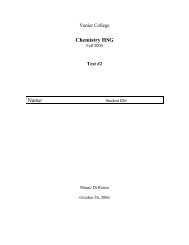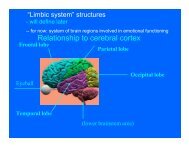Summary of research findings on marijuana Review of literature ...
Summary of research findings on marijuana Review of literature ...
Summary of research findings on marijuana Review of literature ...
Create successful ePaper yourself
Turn your PDF publications into a flip-book with our unique Google optimized e-Paper software.
<strong>marijuana</strong> comes from plant cannabis sativapsychoactive ingredient is delta-9-tetrahydrocannabinol (THC)Historical Informati<strong>on</strong>:• hemp is made from fibre <str<strong>on</strong>g>of</str<strong>on</strong>g> the stem - has beenmade into rope, cloth, towels, paperInteresting fact: Until 1880, much <str<strong>on</strong>g>of</str<strong>on</strong>g> world’s papermade from hemp. Even today, many bank notesprinted <strong>on</strong> cannabis paper - tough and durable-evidence <str<strong>on</strong>g>of</str<strong>on</strong>g> hemp use (as fibre) as far back as10,000 yrs ago in China-evidence <str<strong>on</strong>g>of</str<strong>on</strong>g> use as intoxicant/perhaps inreligious/shamanistic practices in N-E Asia inNeolithic times (St<strong>on</strong>e Age); written records inIndia as far back as 1000 yrs ago
Interesting statistic: In both U.S. and Britain, although usagerates vary, the ratio <str<strong>on</strong>g>of</str<strong>on</strong>g> TLO (Tried atLeast Once) to ULM (have Used in theLast M<strong>on</strong>th) to is quite similar at 4:1;in other words, it appears that <strong>on</strong>ly about25% <str<strong>on</strong>g>of</str<strong>on</strong>g> those who try <strong>marijuana</strong>c<strong>on</strong>tinue to use it, and the rates <str<strong>on</strong>g>of</str<strong>on</strong>g>c<strong>on</strong>tinued use vary widely from a fewtimes a year to several joints per day
• Reas<strong>on</strong>s For Use:• (1977 survey <str<strong>on</strong>g>of</str<strong>on</strong>g> 522 British users, mainly 15-25yrs, predominantly students or recent grads) • Social uplift (pleasure, relaxati<strong>on</strong>, increasedsociability) 58% • Alternative to alcohol (less harmful) 32% • Increased awareness & understanding 25% • “Simply like it” 24%
• Patterns <str<strong>on</strong>g>of</str<strong>on</strong>g> use (Independent DrugM<strong>on</strong>itoring Unit, Britain, 1997, survey <str<strong>on</strong>g>of</str<strong>on</strong>g>2469 “regular” users)• Wide range: median = 14 gm resin/m<strong>on</strong>th; substantial majority did notexceed this; about 5% were “heavyusers”, more or less “permanentlyst<strong>on</strong>ed”, > 3.5 gm/resin day
How THC worksIn ‘80s and ‘90s, experiments revealedthat THC (and its synthetic analogues)bound to unique neur<strong>on</strong> receptor siteswhich were named CB-1• The discovery <str<strong>on</strong>g>of</str<strong>on</strong>g> the receptors led tosearch for a naturally occurring brainchemical that bound to it• >>> discovered in the Israeli lab thathad first established that THC wasactive comp<strong>on</strong>ent <str<strong>on</strong>g>of</str<strong>on</strong>g> <strong>marijuana</strong>.• * Named it anandamide (after Sanskrit“ananda” = “bliss”)
Effects• • Note: subjective experience depends<strong>on</strong> dose, setting, mood (e.g., depressedvs elated), expectati<strong>on</strong>s, prior familiarity• alters way sensory inputs are processed andinfluences thought processes• Tends to be a euphoriant (mood enhancer)• Quickening <str<strong>on</strong>g>of</str<strong>on</strong>g> mental associati<strong>on</strong>s-- maypartially account for quickened sense <str<strong>on</strong>g>of</str<strong>on</strong>g>humour (p. 82)• At higher levels <str<strong>on</strong>g>of</str<strong>on</strong>g> intoxicati<strong>on</strong> (“st<strong>on</strong>ed”)<str<strong>on</strong>g>of</str<strong>on</strong>g>ten relaxed, peaceful, reportedly pr<str<strong>on</strong>g>of</str<strong>on</strong>g>oundthoughts
• at very high levels, fleetinghallucinati<strong>on</strong>s may occur;• also, P may become introspective,dwelling <strong>on</strong> metaphysical topics >transcendental insights• appetite increases (the “st<strong>on</strong>edmunchies”!)• enhanced appreciati<strong>on</strong>, enjoyment <str<strong>on</strong>g>of</str<strong>on</strong>g>food
Negative effects (subjective)• initial lightheadedness and dizziness,sometimes nausea, headache (morepr<strong>on</strong>ounced in in inexperienced users)• fear and anxiety (esp. if dose higher thannormal); can resemble panic attack• Laboratory studies: Problems in standardizingdose; and based <strong>on</strong> fact that experiencedusers can experience very different effectsthan naive Ss;• In additi<strong>on</strong>: Interesting point (made in Ch. 1)that experienced users have learned to selfregulatethe high by c<strong>on</strong>trolling intake almost<strong>on</strong> puff-by-puff basis
• Effect <strong>on</strong> psychomotor functi<strong>on</strong>: neg. effect <strong>on</strong>balance, fine motor c<strong>on</strong>trol, reacti<strong>on</strong> times (thelatter effect is relatively small)• Tests <str<strong>on</strong>g>of</str<strong>on</strong>g> driving impairment: early studiesshowed relatively little or no impairment; morerecent, sophisticated tests: impairment in morecomplex tasks, such as lane c<strong>on</strong>trol;• interesting: unlike alcohol intoxicati<strong>on</strong>,experienced st<strong>on</strong>ed drivers recognizeimpairment and usually take steps tocompensate (e.g., keep greater followingdistance)
• Findings that as many as 10% (in var.studies) <str<strong>on</strong>g>of</str<strong>on</strong>g> drivers involved in driving fatalitiestested positive for THC should take intoaccount that in 70-90% <str<strong>on</strong>g>of</str<strong>on</strong>g> these cases,alcohol also found: Problem may beinteracti<strong>on</strong> effect.• Tests <strong>on</strong> pilots: tasks more complex; manyrequire divided attenti<strong>on</strong>; in simulators,performance c<strong>on</strong>sistently found to beimpaired, even 24 hours after ******• C<strong>on</strong>clusi<strong>on</strong>: risks increase with taskcomplexity, lack <str<strong>on</strong>g>of</str<strong>on</strong>g> familiarity
Learning, Memory and other higher functi<strong>on</strong>s• sensory sensitivity in lab tests not heightened;reported effects presumably at perceptual level• lab tests c<strong>on</strong>firm overestimati<strong>on</strong> <str<strong>on</strong>g>of</str<strong>on</strong>g> elapsed time• Most Ss show little effect <strong>on</strong> tests requiring shorttermvigilance / attenti<strong>on</strong>; but performance falls <str<strong>on</strong>g>of</str<strong>on</strong>g>f ifc<strong>on</strong>centrati<strong>on</strong> required l<strong>on</strong>ger• Impairment is most obvious in short-term memory:dose-dependent impairment in digit-span tests,word list tests• predominant error is <str<strong>on</strong>g>of</str<strong>on</strong>g> “intrusi<strong>on</strong>”: reportingitems that weren’t given• deficits become more pr<strong>on</strong>ounced if distractingstimuli presented during delay interval
• Hypothesis: Impairments in short-termmemory may underlie difficulty in maintainingcoherent train <str<strong>on</strong>g>of</str<strong>on</strong>g> thought - “...cannotremember where the train <str<strong>on</strong>g>of</str<strong>on</strong>g> thoughtbegan...” (p.94)• Acute effects <strong>on</strong> STM wear <str<strong>on</strong>g>of</str<strong>on</strong>g>f after 3-4hours, although some impairment may befound up to 12-24 hours.
Persistent effects <str<strong>on</strong>g>of</str<strong>on</strong>g> Marijuana <strong>on</strong> intellectualfuncti<strong>on</strong>ing?:• • recent review <str<strong>on</strong>g>of</str<strong>on</strong>g> <strong>literature</strong> by vanAmsterdam (1996) points outmethodological flaws in many studies(poorly matched or no c<strong>on</strong>trol groups;testing d<strong>on</strong>e too so<strong>on</strong> after recent use[no washout])• Data: persistent effects from l<strong>on</strong>g-termuse have been reported but data areequivocal and inc<strong>on</strong>sistent
• • Study (Fletcher et al. 1996) <str<strong>on</strong>g>of</str<strong>on</strong>g>frequent l<strong>on</strong>g-term users in Costa Ricafound no differences <strong>on</strong> battery <str<strong>on</strong>g>of</str<strong>on</strong>g>neuropsychological tests;• more recent follow-up <strong>on</strong> small group <str<strong>on</strong>g>of</str<strong>on</strong>g>subjects (N=17, age > 45, average use= 34 years, 5 joints per day) foundimpairment :~ 10% poorer than c<strong>on</strong>trols <strong>on</strong> smallproporti<strong>on</strong> <str<strong>on</strong>g>of</str<strong>on</strong>g> the tasks (the morecomplex verbal memory tasks)
• • However: Nadia Solowij has studiedcognitive impairments in l<strong>on</strong>g-term users usingmore sensitive measures (ERP):• Found (1998) deficits in tests <str<strong>on</strong>g>of</str<strong>on</strong>g> ability toorganize and integrate complex cognitive info;• <strong>on</strong> resp<strong>on</strong>ses to auditory stimuli requiring S to make decisi<strong>on</strong> and take acti<strong>on</strong>; <strong>on</strong>e comp<strong>on</strong>ent <str<strong>on</strong>g>of</str<strong>on</strong>g>the ERP is delayeddeficit in selective attenti<strong>on</strong> ( reduced ability to rejectcomplex irrelevant stimuli)• C<strong>on</strong>clusi<strong>on</strong>: There may be mild deficits inexecutive functi<strong>on</strong>s, but these deficitsmay not have much impact <strong>on</strong> normalday-to-day functi<strong>on</strong>ing.
Does <strong>marijuana</strong> use increase risk <str<strong>on</strong>g>of</str<strong>on</strong>g> psychosis?• [informati<strong>on</strong> to be added]


